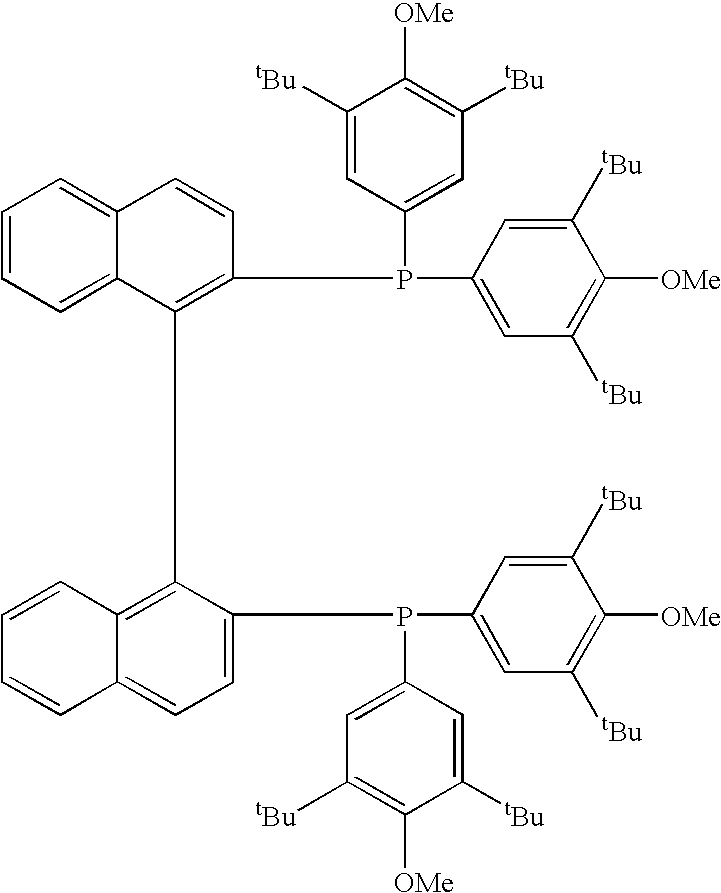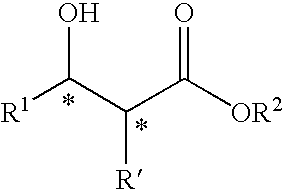Transition metal complex having diphosphine compound as ligand
- Summary
- Abstract
- Description
- Claims
- Application Information
AI Technical Summary
Benefits of technology
Problems solved by technology
Method used
Image
Examples
reference example 1
(S)-2,2′-bis(trifluoromethanesulfonyloxy)-1,1′-binaphthyl
[0082] To a solution of (S)-1,1′-bi-2-naphthol (26.2 g, 91 mmol) in acetonitrile (130 mL) was added pyridine (19.5 g, 2.7 equivalents) at room temperature. Then, trifluoromethanesulfonic anhydride (64.2 g, 2.5 equivalents) was added at 5° C., and the mixture was stirred at 5° C. to 10° C. for 2 hours. After water (100 mL) was added at 3° C. and then ethyl acetate (130 mL) was added, the mixture was stirred at room temperature for 30 minutes. The reaction solution was allowed to separate into layers. An organic layer was washed with water (50 mL) and then concentrated under reduced pressure. To the residue were added diisopropyl ether (150 mL) and active carbon (0.25 g), and the mixture was stirred at 60° C. for 30 minutes. The active carbon was filtered off and the filtrate was concentrated under reduced pressure. The residue was recrystallized from heptane to obtain the title compound (48.9 g, white crystal). Yield 97%.
[008...
reference example 2
4-Bromo-2,6-di-tert-butylanisole
[0084]
[0085] Under argon atmosphere, to a solution of 4-bromo-2,6-di-tert-butylphenol (50 g, 0.175 mol) and potassium carbonate (96.7 g, 4.0 equivalents) in acetone (750 mL) was added dimethyl sulfate (38.6 g, 1.75 equivalents) at 22° C. The mixture was stirred under reflux for 13 hours. Insoluble substances were filtered off and the solvent was distilled off under reduced pressure. By adding ethyl acetate (150 mL) and water (100 mL) to the residue, the reaction mixture was allowed to separate into layers. An organic layer was washed successively with water (100 mL), a 5% NaHCO3 aqueous solution (100 mL) and a 5% NaCl aqueous solution (100 mL), dried over anhydrous magnesium sulfate and then naturally filtered. The filtrate was concentrated under reduced pressure to obtain the title compound (56.1 g, brown oil). Yield 95.2%.
[0086]1H-NMR (300 MHz, CDCl3, TMS) δ: 1.41 (s, 18H), 3.68 (s, 3H), 7.33 (s, 2H).
reference example 3
Bis(3,5-di-tert-butyl-4-methoxyphenyl)phosphine oxide
[0087]
[0088] Under argon atmosphere, a solution of magnesium (4.0 g, 0.95 equivalents) and a small amount of iodine in THF (50 mL) was stirred at room temperature for 1 hour. After 4-bromo-2,6-di-tert-butylanisole (52 g, 0.175 mol) synthesized in Reference Example 2 was added at 46° C. to 53° C. thereto, the mixture was stirred at 5° C. for 1 hour. Then, dimethyl phosphite (11.4 g, 0.52 equivalents) was added and the mixture was stirred at 5° C. for 1 hour. After water (50 mL) was added at 3° C. and toluene (50 mL) and 6M-HCl (20 mL) were then added, the mixture was stirred at room temperature for 30 minutes. The reaction solution was allowed to separate into layers. An organic layer was washed successively with water (20 mL), a 5% NaHCO3 aqueous solution (20 mL) and a 5% NaCl aqueous solution (20 mL), dried over anhydrous magnesium sulfate and then naturally filtered. The filtrate was concentrated under reduced pressure. The res...
PUM
| Property | Measurement | Unit |
|---|---|---|
| Optical activity | aaaaa | aaaaa |
| Reduction potential | aaaaa | aaaaa |
Abstract
Description
Claims
Application Information
 Login to View More
Login to View More - R&D
- Intellectual Property
- Life Sciences
- Materials
- Tech Scout
- Unparalleled Data Quality
- Higher Quality Content
- 60% Fewer Hallucinations
Browse by: Latest US Patents, China's latest patents, Technical Efficacy Thesaurus, Application Domain, Technology Topic, Popular Technical Reports.
© 2025 PatSnap. All rights reserved.Legal|Privacy policy|Modern Slavery Act Transparency Statement|Sitemap|About US| Contact US: help@patsnap.com



